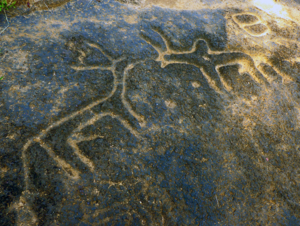Goa's history stretches back to 8000-6000 BC. Early Paleolithic and Mesolithic rock art engravings have been found on the bank of river Kushavati at Usgalimal.Petroglyphs,cones,stone-axe,choppers dating back 10,000 years back have been found in many places in Goa like Kazur,Mauxim and the Mandovi-Zuari basin.Palaeolithic cave existence is seen at Dabolim, Adkon, Shigao, Fatorpa, Arli, Maulinguinim, Diwar, Sanguem, Pilerne, Aquem-Margaon etc. Difficulty in carbon dating the laterite rock compounds poses problems in determination of exact time period. These discoveries have shed light on Goa's prehistory.
The Sumerians inhabited Goa around 2200 BC which was followed by several waves of Indo-Aryan people and the Dravidians from the Deccan. The early Goan society underwent radical changes when aboriginal locals and the migrants amalgamated, forming the base of early Goan culture.
In 3rd century BC, it formed part of the Mauryan Empire, ruled by the Buddhist emperor, Ashoka of Magadha. Buddhist monks laid the foundation of Buddhism in Goa. Between the 2nd century BCE and the 6th century CE, Goa was ruled by the Chutus of Karwar as feudatories of the Satavahanas of Kolhapur (2nd century BCE to the 2nd century CE), Western Kshatrapas (around 150 CE), the Abhiras of Western Maharashtra, Bhojas of the Yadav clans of Gujarat, and the Konkan Mauryas as feudatories of the Kalachuris. The rule later passed on to the Chalukyas of Badami, who controlled it between 578 to 753, and later the Rashtrakutas of Malkhed from 753 to 963. However from 765 to 1015, the Southern Silharas of Konkan ruled Goa as the feudatories of the Chalukyas and the Rashtrakutas. Over the next few centuries, Goa was successively ruled by the Kadambas as the feudatories of the Chalukyas of Kalyani. They patronised Jainism in Goa.
In 1312, Goa came under the governance of the Delhi Sultanate. However, the kingdom's grip on the region was weak, and by 1370 they were forced to surrender it toHarihara I of the Vijayanagara empire. The Vijayanagara monarchs held on to the territory until 1469, when it was appropriated by the Bahmani sultans of Gulbarga. After that dynasty crumbled, the area fell to the hands of the Adil Shahis of Bijapur who established as their auxiliary capital the city known under the Portuguese as Velha Goa.
In 1510, the Portuguese defeated the ruling Bijapur kings with the help of a local ally, Timayya, leading to the establishment of a permanent settlement in Velha Goa (or Old Goa).
In 1843 the capital was moved to Panjim from Velha Goa. By the mid-18th century the area under occupation had expanded to most of Goa's present day state limits. Simultaneously the Portuguese lost other possessions in India until their borders stabilised and formed the Estado da India Portuguesa, of which Goa was the largest territory.
After India gained independence from the British in 1947, Portugal refused to negotiate with India on the transfer of sovereignty of their Indian enclaves. On 12 December 1961, the Indian Army commenced with Operation Vijay resulting in the annexation of Goa, Daman and Diu into the Indian union. Goa, along with Daman and Diu was made into a centrally administered Union Territory of India. On 30 May 1987, the Union Territory was split, and Goa was made India's twenty-fifth state, with Daman and Diu remaining Union Territories.




No comments:
Post a Comment